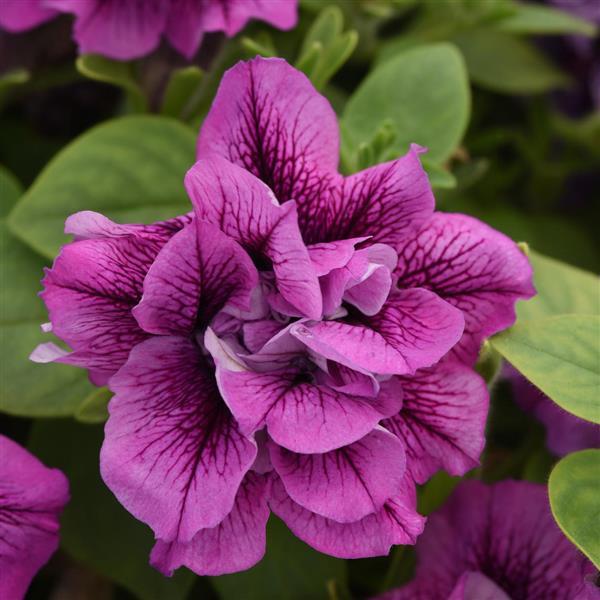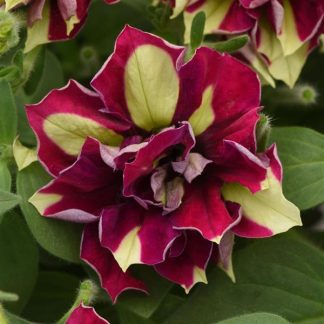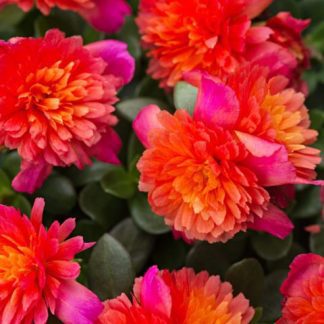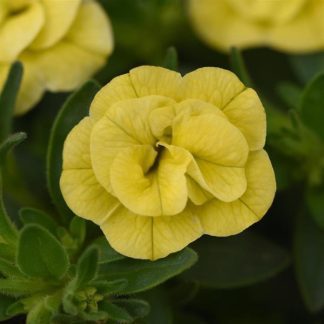Description
Double Vogue Lavender Vein Petunia: Layers of Soft Drama for Every Garden
A Dream in Violet and White
You step outside, and there it is—an overflowing basket of velvety blooms that look painted by twilight. Double Vogue Lavender Vein Petunia greets you with plush, ruffled petals splashed in lilac, violet, and thin silver‐white veins. Each blossom resembles a tiny ballerina dress, full and layered, yet light as air. The color deepens toward the throat, making every flower feel like a secret window into dusk. Plants spill elegantly from containers, trail over retaining walls, and fill garden beds with gentle movement. Their mounded habit, about ten to twelve inches tall and up to twenty inches wide, creates waves of floral texture that invite a closer look. In other words, the effect is pure garden theater—but most of all, it is welcoming and easy to grow.
Why We All Fall for Double Blooms
Single blooms are lovely. Double blooms, however, tell a richer story. They bring depth, shadow, and a plush feeling you can almost touch. Instead of a flat disc of color, you get layers that catch light differently throughout the day. After more than one season, many gardeners confess they cannot imagine summer without these frothy flowers. Double Vogue Lavender Vein stands out because each blossom is consistent in form. The petals rarely split or show gaps. That means your containers always look tidy, as if freshly fluffed by an invisible stylist. Bees and butterflies still find their way around the deeper center, so pollinator visits remain steady while you enjoy the extra fullness.
Perfect Spots to Show Off
Hanging Baskets
Hang one near the front porch. Let the vines tumble over the rim. As breezes pass, flowers dance. Guests will pause, look up, and smile.
Window Boxes
We love placing Double Vogue Lavender Vein against white or pale gray siding. The veins pop, and the whole front of the house feels softer.
Raised Beds and Borders
In a raised bed, tuck plants along the edge. They will cascade just enough to blur harsh lines. In the border, pair them with feathery grasses. The contrast between fluffy petals and upright blades creates a living tapestry.
Mixed Containers
Combine with silver‐leafed dusty miller, soft pink calibrachoa, and dark purple sweet potato vine. The look is cohesive yet vibrant, like a well‐composed song.
Light That Makes Color Glow
Give these petunias at least six hours of direct sun. Morning light is gentle and prevents scorching. Hot southern exposure all day can lead to faded veins. If you live where summers sizzle, a bit of afternoon shade keeps blooms vivid. That said, they refuse to sulk in light dappled by an open pergola. The goal is bright, but not baking.
Soil: Fluffy, Fresh, Full of Life
Double blooms demand steady moisture, yet they hate wet feet. Use a premium potting mix rich in peat or coco coir. Add a scoop of fine compost for slow release nutrients. In ground beds, loosen soil twelve inches deep and amend heavy clay with composted pine bark. Good drainage means roots grab oxygen, and your petunias repay you with non‐stop flowers.
Watering: A Friendly Routine
Think of watering as a conversation. Touch the mix. If the top inch feels dry, it is time. Water at the base until it flows from drainage holes. Early morning is ideal; leaves dry faster, reducing disease chances. On scorching afternoons, wilted leaves tell you they need a drink. They bounce back quickly. We like to set drip emitters to run ten minutes every day for baskets and three times a week for in‐ground beds. Adjust as weather shifts. In other words, keep it steady, keep it sensible, and your plants will stay happy.
Feeding for Continuous Show
Double petunias bloom their hearts out. That means they crave nutrients. Use a balanced, water‐soluble fertilizer (for instance, 10-10-10) at half strength every week. Liquid seaweed once a month boosts trace minerals. If you prefer slow‐release granules, sprinkle them at planting time and top up midsummer. But most of all, watch the foliage color. Pale leaves tell you it is feeding time.
Pruning and Pinching: Light Touch, Big Rewards
Deadheading doubles look tricky, yet it is simple. Spent flowers hide inside new layers. Pinch the whole bloom cluster off with your thumb and forefinger. This prevents seed set and pushes new buds. Once in mid-summer, give the entire plant a light haircut. Trim back stems by one-third. After more than ten days, you will see fresh growth and fuller bloom clusters.
Pests and Problems, Solved
- Aphids: Spray with a strong jet of water, then apply insecticidal soap.
- Caterpillars: Handpick or use organic Bt spray.
- Powdery Mildew: Improve air flow, water early, and treat with neem oil.
- Yellow Leaves: Check for overwatering or nutrient gaps. Adjust accordingly.
Instead of worrying, keep a weekly inspection habit. Quick action stops trouble before it spreads.
Propagation Magic: Seeds and Cuttings
Starting Seeds
- Sow eight to ten weeks before your last frost.
- Press seeds onto moist seed mix. Do not cover; they need light to germinate.
- Mist gently and cover with a clear dome.
- Maintain 70 °F warmth and bright light.
- Germination takes seven to ten days. Remove dome when sprouts appear.
Taking Cuttings
- Choose a non‐flowering shoot four inches long.
- Snip beneath a leaf node and remove lower leaves.
- Dip in rooting hormone, then place in a perlite‐rich mix.
- Keep humidity high and light bright but indirect.
- Roots form in two weeks. Transplant once growth resumes.
Propagation lets you multiply your favorite color without hunting for more pots at the garden center. After more than one season, you may become the friend who gifts baby plants to everyone.
Seasonal Care and Overwintering
In cold zones, this petunia is an annual. Frost ends the party. Still, you can enjoy an extra month by moving containers under a patio roof during cool nights. If you crave year-round color, overwinter one mother plant indoors:
- Trim back by half.
- Place near a south-facing window.
- Keep soil barely moist.
- Pinch new growth to maintain shape.
When spring returns, cuttings from this mother will jump-start your displays.
Design Ideas That Spark Joy
Cool Calm Blend
Pair Double Vogue Lavender Vein with pale blue lobelia and white bacopa. The palette feels like early morning sky.
Sunset Splash
Combine with coral calibrachoa, bright yellow million bells, and trailing orange nasturtiums. Veined lavender acts as a soothing echo amid warm tones.
Moonlight Basket
Add silver plectranthus and white alyssum. Place under soft night lighting. The variegated veins catch every stray beam.
Cottage Gathering
Surround with pink cosmos, soft lavender, and airy baby’s breath. Bees will thank you, and so will passers-by.
Troubleshooting Quick Guide
| Symptom | Likely Cause | Simple Fix |
|---|---|---|
| Fewer Blooms | Not enough sun | Move to brighter spot |
| Brown Petal Edges | Heat stress | Provide light afternoon shade |
| Wilting even when moist | Root rot | Improve drainage, let dry slightly |
| Sticky Leaves | Aphids | Wash off, apply soap spray |
Keep this chart handy. It turns worry into action in seconds.
Fun Facts to Share
- Petunias belong to the nightshade family, just like tomatoes.
- Double varieties began as specialty crosses in Victorian times. They were prized for indoor parlor displays.
- Lavender veins attract more bees than flat colors because bees see ultraviolet patterns humans cannot.
After more than one conversation with fellow gardeners, you will notice these facts spark lively chats.
Growing With Kids and Community
Invite children to touch the soft petals. They will describe them as “mini pillows.” Let them water with small cans. They learn responsibility and patience. In community gardens, planting a row of Double Vogue Lavender Vein along paths draws neighbors in. People pause, talk, and share stories. The plant becomes a connector—proof that simple beauty builds friendship.
Sustainable Tips
- Use rainwater collected in barrels for irrigation. Petunias love the slightly acidic pH.
- Mulch containers with shredded leaves to reduce evaporation.
- When blooms fade in fall, add spent plants to the compost pile. They break down quickly and feed next year’s soil.
In other words, care for your petunias, and they teach you gentle stewardship in return.
Quick Reference Care Card
Light: 6+ hours sun
Height: 10–12 inches
Spread: 18–20 inches
Soil: Well-drained, rich, pH 6.0–6.5
Water: When top inch is dry
Fertilizer: Half-strength weekly liquid or slow-release granules
Deadhead: Yes, pinch clusters
Hardiness: Annual; protect from frost
Print this card. Tape it near your potting bench. We all forget details on busy days.
How Double Vogue Lavender Vein Fits Into Larger Design Plans
Plant it as the lead singer in a pastel medley, or let it play backup harmony behind bold cannas. Use it to soften brick walls, bridge the color gap between pink roses and purple salvia, or fill the gap after spring bulbs fade. Because its bloom power runs from late spring to first frost, it covers seasonal lulls effortlessly. That means fewer bare spots and more time admiring, less time re‐planting.
Beyond the Garden: Decorating Ideas
Cut a handful of stems early in the morning. Float blooms in a shallow bowl for a quick centerpiece. Press petals between parchment and heavy books to make delicate bookmarks. Tuck fresh flowers into gift wrap ribbons. The double layers hold shape longer than singles, adding a touch of luxury.
Community Stories
Maya from Dallas planted Double Vogue Lavender Vein along her grandmother’s wheelchair ramp. The trailing vines followed the slope, making every trip outside a burst of color. Tom in Michigan grew them in whiskey barrels beside his driveway. Neighbors stopped daily for photos. After more than one curious question, he ended up sharing cuttings and advice, turning the entire street into a lavender‐veined lane.
A Few Words on Climate Adaptation
Hot, humid July afternoons can lead to fungal issues. Space containers for airflow and avoid overhead watering. In dry mountain climates, you may water twice a day during heat waves. Remember, flexible care meets individual climate needs. Observe, adjust, succeed. That simple rhythm works everywhere.
Petunia Etiquette: Companion Behavior
Petunias play well with herbs like basil and mint. Both deter pests. Avoid pairing with aggressive trailing sweet alyssum in tiny pots; the alyssum may crowd root space. In vegetable beds, use Double Vogue Lavender Vein as a living mulch between tomato plants. It shades soil, reducing weeds, and adds color to a functional plot.
Savoring the Scent
While not as fragrant as some grandiflora types, these doubles release a faint honey note on warm evenings. Place baskets near outdoor seating. Sip tea. Enjoy the gentle perfume. Life slows down, and tiny joys feel larger.
Final Care Checklist
- Planting Time: After danger of frost. Soil temp 60 °F.
- First Feed: Two weeks after planting.
- Mid-Season Trim: Early July. Cut back by one-third.
- Daily Glance: Check moisture and spent blooms.
- Season End: Compost or overwinter mother plant indoors.
Follow this checklist, and success feels inevitable.
Celebrate Every Velvet Ripple
Double Vogue Lavender Vein Petunia gives us more than petals. It offers daily reminders that simple acts—watering, trimming, noticing—create layers of beauty, much like its own blooms stack color upon color. When we care for these flowers, we practice patience, nurture creativity, and invite community. Plant one basket or fill an entire bed. Either way, you weave softness into the landscape and joy into your routine. So let us embrace those velvet ripples, share them widely, and watch our gardens—and our spirits—lift in lavish lavender.




